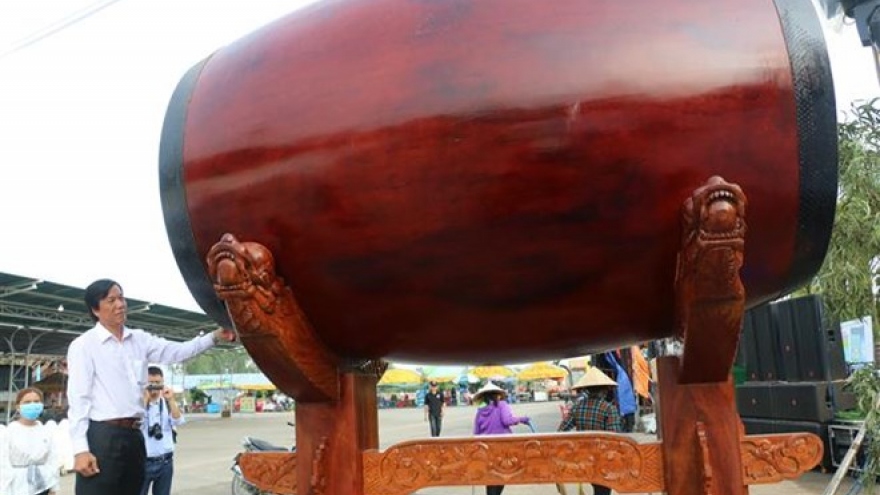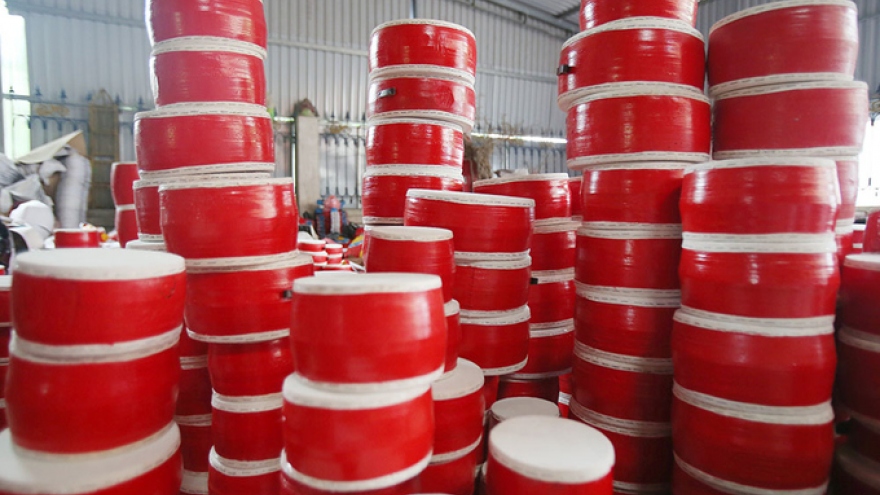Doi Tam village and the art of drum making
VOV.VN - In Vietnam, drums are a traditional instrument at festivals and weddings. They are also used to announce arrivals to the community, signal when school starts or ends, and accompany musical performances.
 |
Doi Tam village is famous for drum-making. Located at the foot of scenic Doi Mountain in the northern province of Ha Nam, the craft village has been making drums for more than a thousand years.
Le Ngoc Minh, the village chief, said “Our drum making is said to have a 1,000-year history. The founder of the craft was Nguyen Duc Nang. In 987, to welcome King Le Dai Hanh to Doi Tam village to attend a plough ceremony, Nang made a giant drum to present to the King. The drum when played created sounds like thunder. Nang was given the title ‘Master of Thunder’. Drums are used in all kinds of festivals.”
To make a good drum requires great care and expertise in choosing and assembling materials. To create the right sound for each drum, the work must be precise and often involves secrets handed down from generation to generation.
Artisan Pham Chi Khang said assembling the drum barrel is the most important stage.
“This is a village secret. In 2007, Doi Tam village was one of the first 12 handicraft villages granted by the Vietnam Craft Village Association the title ‘outstanding craft village’ of Vietnam’. Other villages make drums but they can’t match our drums’ characteristics. Many others try to imitate our style,” Khang elaborated.
He recalled “The biggest drum I ever made was a royal drum 3.1 meters high and 2.35 meters in diameter. The biggest drum in Southeast Asia was also made by Doi Tam villagers. The bigger a drum is, the more precision it requires, and the more time it takes.”
 |
| The Doi Tam female drummer team |
Tran Dinh Tien, head of the Culture and Information Section in Duy Tien district, said “In the old days, drums were used in combat against foreign invaders. Drumming invites people to participate in community activities. The drum is an indispensable part of community festivals because it wakes up spirits.”
Doi Tam produces many kinds of drums, ranging from drums for Cheo singing to drums for festivals or schools, with diameters ranging from 20cm to 2m. To celebrate the 990th anniversary of Thang Long-Hanoi, Doi Tam craftsmen made the largest drum in Vietnam, which is now at the Temple of Literature in Hanoi. The drum is more than 2 meters in diameter, 2.65m in height, and 10cu.m in volume.
Artisan Khang said "We produce about 25 types of drums. Drums for rituals or sacrifice offering rites are called spiritual or worship drums. Drums used at community festivals are called festival drums. Drums used in pagodas are different from those in temples or communal houses. For example, the drum used in a communal house should be big. Its sound represents the tutelary god who rules the village. The drum in a temple which worships saints is of medium size. But a pagoda drum can be small. That’s why I say, depending on its purpose, a person can order a big or small drum.”
A drum is made in 3 stages: leather tanning, drum-barrel making, and drumhead stretching. Doi Tam craftsmen use buffalo skins to make drum heads. They shave buffalo leather until it becomes very thin, and then dry it in the sun. The drum-barrel is made of dried jackfruit wood. Stretching a drumhead is the most difficult task because it requires an artisan’s skill to assess the sound.
According to artisan Khang, drum makers choose a pattern to suit each type of drums.
“The pattern depends on the drum’s purpose. For example, we draw clouds on festival drums. For pagoda, temple, or communal house drums, common patterns are dragon-shaped clouds. Temple drums might also have phoenixes. Patterns on drums used by members of art troupes are brocade designs or something similar to the motifs of bronze drums. Drums for cultural events are decorated with cranes. The drumheads of festival drums, of course, must have light rays spreading out to symbolize the world,” Khang explained.
The village has formed a 60-member drumming team to perform at festivals nationwide. The team includes 48 married women and 12 older men who play bronze musical instruments like gongs and cymbals.
Le Thi Thuy Thuong, a member of the team, said membership is a great honor.
“Although I’m busy with farming, I was ready to join the team as soon as I was asked. The female team members are excited to bring Doi Tam drumbeats to places across the country. Though the remuneration is not much, we like playing drums and love helping to preserve a traditional craft,” Huong explained.
In the decade since its establishment, the team has become widely known for its jubilant sound, which at times suggests a troop setting off for battle.
Le Thi Dao, another team member, said the team practices hard. She said: “At first it was quite difficult. I had to learn from the other team members who were already skilled in drum techniques. I play backing drum to complement the ones in the front line who play the main drums. Playing drums has become the village’s culture. It feels great to be hired to play for an event. We usually perform just one day.”
As a native of Doi Tam village, Do Thi Nguyet learned to make drums from her parents when she was a little girl. She has become an expert in all steps, even the most difficult ones.
Nguyet, who is now the head of the Doi Tam drum team, said she can play every piece correctly, even with her eyes closed.
“We can play the drums for all kinds of festivals. The plough ceremony, for example, which involves drumming for a procession, is followed by drumming to welcome guests, and then a finale. Each part lasts 5 to 7 minutes,” Nguyet said.


